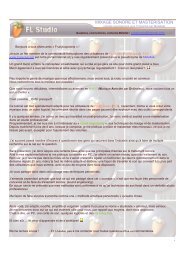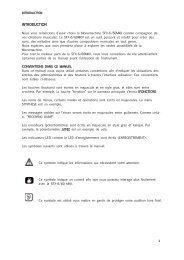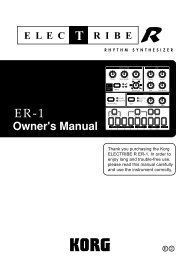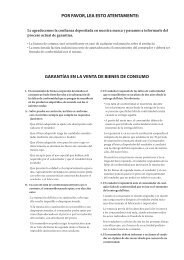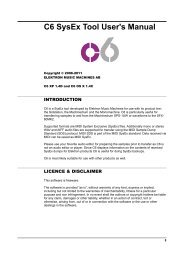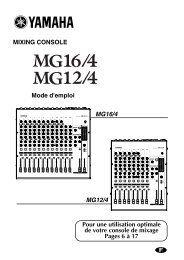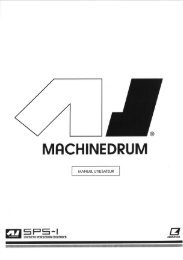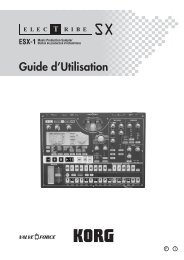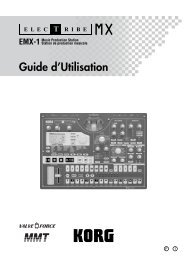- Page 3 and 4:
©2000 Access Music GmbH, Germany.
- Page 5 and 6:
AUDIO INPUTS - 83 Audio Inputs.....
- Page 7:
LFOs ..............................
- Page 10 and 11:
8 CHAPTER 2 Safety Remarks Always
- Page 12 and 13:
10 CHAPTER 2 Safety Remarks
- Page 14 and 15:
12 CHAPTER 3 Prologue With the bene
- Page 16 and 17:
14 CHAPTER 3 Prologue Although far
- Page 18 and 19:
16 CHAPTER 4 Introduction THE VIRUS
- Page 20 and 21:
18 CHAPTER 4 Introduction cate the
- Page 22 and 23:
20 CHAPTER 4 Introduction THE AMPLI
- Page 24 and 25:
22 CHAPTER 4 Introduction lower the
- Page 26 and 27:
24 CHAPTER 4 Introduction HP the h
- Page 28 and 29:
26 CHAPTER 4 Introduction open, the
- Page 30 and 31:
28 CHAPTER 4 Introduction ter posit
- Page 32 and 33:
30 CHAPTER 4 Introduction The reaso
- Page 34 and 35:
32 CHAPTER 4 Introduction FILTER RO
- Page 36 and 37:
34 CHAPTER 4 Introduction THE FIRST
- Page 38 and 39:
36 CHAPTER 4 Introduction You can c
- Page 40 and 41:
38 CHAPTER 4 Introduction Locate th
- Page 42 and 43:
40 CHAPTER 4 Introduction of select
- Page 44 and 45:
42 CHAPTER 4 Introduction control).
- Page 46 and 47:
44 CHAPTER 4 Introduction the sound
- Page 48 and 49:
46 CHAPTER 4 Introduction You can a
- Page 50 and 51:
48 CHAPTER 4 Introduction VELOCITY
- Page 52 and 53:
50 CHAPTER 4 Introduction THE CHORU
- Page 54 and 55:
52 CHAPTER 4 Introduction MORE TO C
- Page 56 and 57:
54 CHAPTER 5 Concept and Operation
- Page 58 and 59:
56 CHAPTER 5 Concept and Operation
- Page 60 and 61:
58 CHAPTER 5 Concept and Operation
- Page 62 and 63:
60 CHAPTER 6 Handling PARAMETER SEL
- Page 64 and 65:
62 CHAPTER 6 Handling The menus, pa
- Page 66 and 67:
64 CHAPTER 6 Handling the full cont
- Page 68 and 69:
66 CHAPTER 6 Handling
- Page 70 and 71:
68 CHAPTER 7 All about the memory S
- Page 72 and 73:
70 CHAPTER 7 All about the memory
- Page 74 and 75:
72 CHAPTER 8 Master Clock and Midi-
- Page 76 and 77:
74 CHAPTER 8 Master Clock and Midi-
- Page 78 and 79:
76 CHAPTER 9 The Modulation Matrix
- Page 80 and 81:
78 CHAPTER 9 The Modulation Matrix
- Page 82 and 83:
80 CHAPTER 9 The Modulation Matrix
- Page 84 and 85:
82 CHAPTER 10 The Effects Section T
- Page 86 and 87:
84 CHAPTER 11 Audio Inputs AUDIO IN
- Page 88 and 89:
86 CHAPTER 11 Audio Inputs correlat
- Page 90 and 91:
88 CHAPTER 12 Internal Audio Routin
- Page 92 and 93:
90 CHAPTER 12 Internal Audio Routin
- Page 94 and 95:
92 CHAPTER 13 Additional functions
- Page 96 and 97:
94 CHAPTER 14 The Parameters The fo
- Page 98 and 99:
96 CHAPTER 14 The Parameters ENV MO
- Page 100 and 101:
98 CHAPTER 14 The Parameters master
- Page 102 and 103:
100 CHAPTER 14 The Parameters LFO 2
- Page 104 and 105:
102 CHAPTER 14 The Parameters LFO 3
- Page 106 and 107:
104 CHAPTER 14 The Parameters OSCIL
- Page 108 and 109:
106 CHAPTER 14 The Parameters FM AM
- Page 110 and 111:
108 CHAPTER 14 The Parameters TRI
- Page 112 and 113:
110 CHAPTER 14 The Parameters VOLUM
- Page 114 and 115:
112 CHAPTER 14 The Parameters MIXER
- Page 116 and 117:
114 CHAPTER 14 The Parameters FILTE
- Page 118 and 119:
116 CHAPTER 14 The Parameters HP T
- Page 120 and 121:
118 CHAPTER 14 The Parameters TIME
- Page 122 and 123:
120 CHAPTER 14 The Parameters HIGH
- Page 124 and 125:
122 CHAPTER 14 The Parameters AMPLI
- Page 126 and 127:
124 CHAPTER 14 The Parameters also
- Page 128 and 129:
126 CHAPTER 14 The Parameters PORTA
- Page 130 and 131:
128 CHAPTER 14 The Parameters voice
- Page 132 and 133:
130 CHAPTER 14 The Parameters indig
- Page 134 and 135:
132 CHAPTER 14 The Parameters ASSIG
- Page 136 and 137:
134 CHAPTER 14 The Parameters VELOC
- Page 138 and 139:
136 CHAPTER 15 Within the CTRL-Menu
- Page 140 and 141:
138 CHAPTER 15 Within the CTRL-Menu
- Page 142 and 143:
140 CHAPTER 15 Within the CTRL-Menu
- Page 144 and 145:
142 CHAPTER 15 Within the CTRL-Menu
- Page 146 and 147:
144 CHAPTER 15 Within the CTRL-Menu
- Page 148 and 149:
146 CHAPTER 15 Within the CTRL-Menu
- Page 150 and 151:
148 CHAPTER 15 Within the CTRL-Menu
- Page 152 and 153:
150 CHAPTER 16 Parameter of the eff
- Page 154 and 155:
152 CHAPTER 16 Parameter of the eff
- Page 156 and 157:
154 CHAPTER 16 Parameter of the eff
- Page 158 and 159:
156 CHAPTER 16 Parameter of the eff
- Page 160 and 161:
158 CHAPTER 16 Parameter of the eff
- Page 162 and 163:
160 CHAPTER 16 Parameter of the eff
- Page 164 and 165:
162 CHAPTER 16 Parameter of the eff
- Page 166 and 167:
164 CHAPTER 16 Parameter of the eff
- Page 168 and 169:
166 CHAPTER 16 Parameter of the eff
- Page 170 and 171:
168 CHAPTER 16 Parameter of the eff
- Page 172 and 173: 170 CHAPTER 16 Parameter of the eff
- Page 174 and 175: 172 CHAPTER 16 Parameter of the eff
- Page 176 and 177: 174 CHAPTER 17 Global-, MIDI- and S
- Page 178 and 179: 176 CHAPTER 17 Global-, MIDI- and S
- Page 180 and 181: 178 CHAPTER 17 Global-, MIDI- and S
- Page 182 and 183: 180 CHAPTER 17 Global-, MIDI- and S
- Page 184 and 185: 182 CHAPTER 17 Global-, MIDI- and S
- Page 186 and 187: 184 CHAPTER 18 Random Patch Generat
- Page 188 and 189: 186 CHAPTER 18 Random Patch Generat
- Page 190 and 191: 188 CHAPTER 19 Categories SOUND CAT
- Page 192 and 193: 190 CHAPTER 20 The keyboard version
- Page 194 and 195: 192 CHAPTER 20 The keyboard version
- Page 196 and 197: 194 CHAPTER 20 The keyboard version
- Page 198 and 199: 196 CHAPTER 20 The keyboard version
- Page 200 and 201: 198 CHAPTER 20 The keyboard version
- Page 202 and 203: 200 CHAPTER 20 The keyboard version
- Page 204 and 205: 202 CHAPTER 21 The Vocoder of the V
- Page 206 and 207: 204 CHAPTER 21 The Vocoder of the V
- Page 208 and 209: 206 CHAPTER 21 The Vocoder of the V
- Page 210 and 211: 208 CHAPTER 21 The Vocoder of the V
- Page 212 and 213: 210 CHAPTER 21 The Vocoder of the V
- Page 214 and 215: 212 CHAPTER 21 The Vocoder of the V
- Page 216 and 217: 214 CHAPTER 22 The Virus and Sequen
- Page 218 and 219: 216 CHAPTER 22 The Virus and Sequen
- Page 220 and 221: 218 CHAPTER 22 The Virus and Sequen
- Page 224 and 225: 222 CHAPTER 22 The Virus and Sequen
- Page 226 and 227: 224 CHAPTER 22 The Virus and Sequen
- Page 228 and 229: 226 CHAPTER 22 The Virus and Sequen
- Page 230 and 231: 228 CHAPTER 23 Tips, tricks and oth
- Page 232 and 233: 230 CHAPTER 23 Tips, tricks and oth
- Page 234 and 235: 232 CHAPTER 23 Tips, tricks and oth
- Page 236 and 237: 234 CHAPTER 23 Tips, tricks and oth
- Page 238 and 239: 236 CHAPTER 23 Tips, tricks and oth
- Page 240 and 241: 238 CHAPTER 23 Tips, tricks and oth
- Page 242 and 243: 240 CHAPTER 23 Tips, tricks and oth
- Page 244 and 245: 242 CHAPTER 23 Tips, tricks and oth
- Page 246 and 247: 244 CHAPTER 23 Tips, tricks and oth
- Page 248 and 249: 246 CHAPTER 23 Tips, tricks and oth
- Page 250 and 251: 248 CHAPTER 23 Tips, tricks and oth
- Page 252 and 253: 250 CHAPTER 23 Tips, tricks and oth
- Page 254 and 255: 252 CHAPTER 24 Appendix SYSTEM EXCL
- Page 256 and 257: 254 CHAPTER 24 Appendix Polyphonic
- Page 258 and 259: 256 CHAPTER 24 Appendix [256 multi
- Page 260 and 261: 258 CHAPTER 24 Appendix PARAMETERS
- Page 262 and 263: 260 CHAPTER 24 Appendix No. Class N
- Page 264 and 265: 262 CHAPTER 24 Appendix No. Class N
- Page 266 and 267: 264 CHAPTER 24 Appendix No. Class N
- Page 268 and 269: 266 CHAPTER 24 Appendix No. Class N
- Page 270 and 271: 268 CHAPTER 24 Appendix No. Class N
- Page 272 and 273:
270 CHAPTER 24 Appendix No. Class N
- Page 274 and 275:
272 CHAPTER 24 Appendix No. Class N
- Page 276 and 277:
274 CHAPTER 24 Appendix NO REF NAME
- Page 278 and 279:
276 CHAPTER 24 Appendix CLASSES Cla
- Page 280 and 281:
278 CHAPTER 24 Appendix On non-par
- Page 282 and 283:
280 CHAPTER 24 Appendix MOD MATRIX
- Page 284 and 285:
282 CHAPTER 24 Appendix DEFINABLE K
- Page 286 and 287:
284 CHAPTER 24 Appendix MIDI IMPLEM
- Page 288 and 289:
286 CHAPTER 24 Appendix FCC INFORMA
- Page 290 and 291:
288 CHAPTER 24 Appendix FCC INFORMA
- Page 292 and 293:
290 CHAPTER 24 Appendix DECLARATION
- Page 294 and 295:
292 CHAPTER 24 Appendix GARANTIE BE
- Page 296:
294 CHAPTER 24 Appendix



